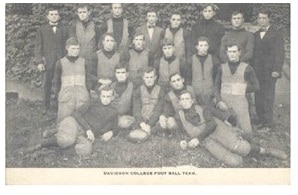DAVIDSON HISTORY
Davidson Hits the Gridiron

What is known as American football began shortly after the Civil War when students at some eastern colleges invented a new game by combining elements of rugby and soccer. In 1867 Princeton students established the first rules for the game, and in 1869 Princeton and Rutgers (then the College of New Jersey) engaged in the first intercollegiate football game. The game was quickly adopted by the Ivy League schools, and in 1876 representatives from Columbia, Harvard, Princeton and Yale wrote the first rules for the game. These were further refined in the 1880s by Walter Camp, a former Yale rugby player.
According to Walter Lingle, intramural football was a feature on the Davidson campus by 1888. In his history of the college, Lingle noted that “The fundamentals of the game were the same as they are now. The forward pass had not yet been introduced. A player could run on a fumbled ball if he was lucky enough to get it. There was no referee with a whistle to blow a signal to down the ball. The player who had the ball could crawl with it after he had been tackled, and the whole opposing team would pile on him until he cried, ‘Down!’…With the flying-wedge and a number of other plays that have since disappeared, it was an even rougher game than it is today.”
According to Cornelia Shaw’s history of the college, students organized a Rugby Football Association in 1889, and that same year they joined the North Carolina Football League. The faculty did not permit intercollegiate games, but in 1890 there was an intramural game on Thanksgiving. According to the Davidson Monthly, “We cannot play Yale at New York or even Trinity…at Charlotte, but gentle friends, we can play Davidson College, and so we did. If we could only get the faculty to think as we do we would gladly test our mettle on foreign foes, but they are mulish, so we have to play among ourselves…None of the players were killed or maimed for life, but honorable blood was shed…” In 1898 the faculty allowed the squad to play two intercollegiate games. According to Mary Beaty’s history of the college, for the first game, a special train was arranged for “young ladies and other townspeople” to travel to Charlotte to play the University of North Carolina. The Davidson College Magazine later reported that “when…Davidson rooters learned that their team had been beaten [by] only eleven points, their enthusiasm knew no bounds.”
After this experiment, the faculty reported to the Board that “the affairs seemed to work very well,” and the Board recommended that “the Faculty deal with the whole matter with such care and discretion as shall on the one hand not discourage the young men nor on the other hand lead to dissipation.” The following year Davidson won one of its six games, and in 1900-1901, the first year when the team had an actual coach, Davidson won seven of eight games, one of these a victory of 38-6 against Georgia Tech.
The following year there was a celebration to honor the team. In December 1902, the Davidson College Magazine reported that “The most ‘brilliant’ event of the season was the torch-light procession Monday night, November 24th, in honor of the football team. According to arrangement at eight o’clock a large part of the student body assembled on the football field with torches ready for lighting. When the signal was given the torches were all lit up, and the procession started, with the foot-ball team leading in a wagon drawn by two horses. After marching through the principal streets of the town the procession drew up in front of Dr. Graham’s residence. Here speeches on the work of the season in foot-ball, and especially on the team’s defeat of the A. and M., were made by Dr. Graham, Dr. Munroe, and several members of the faculty. The crowd then returned to the football field and ended the night’s proceedings with a big bonfire.”
In 1903 Mr. William H. Sprunt of Wilmington provided money to build an athletic field for football, baseball and track. However, in order to have intercollegiate sports, students had promised to take better care of college property, and when this failed to happen, the faculty cancelled two games in April 1904.
In later years, Davidson was involved in an athletics scandal, similar to something we might see today, over players’ eligibility. In 1915 a dispute arose between Davidson and Clemson University on one side and the University of South Carolina on the other. Prof. J.B. Coleman of USC had sent a list of players in a forthcoming game to Professor McConnell at Davidson, and McConnell questioned the eligibility of some players on the list. According to a report in the November 13 edition of Sumter’s Watchman and Southern, “a number of football players were imported from other States to play on the Carolina team, and…When it becomes necessary to import players and to raise a large fund, by calling on the alumni for large contributions, to support a college football team there is something radically wrong with college athletics. There should be not only an investigation but reformation.” On November 19 the Yorkville Enquirer reported that the University of South Carolina had broken off all athletic relations with Davidson for the year.
Nancy Griffith
Nancy Griffith lived in Davidson from 1979 until 1989. She is the author of numerous books and articles on Arkansas and South Carolina history. She is the author of "Ada Jenkins: The Heart of the Matter," a history of the Ada Jenkins school and center.


